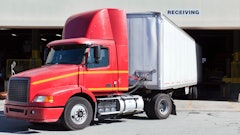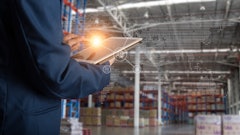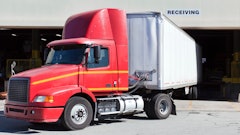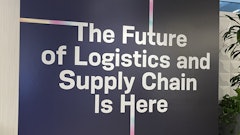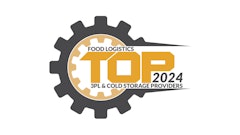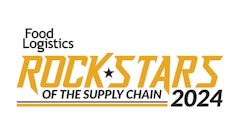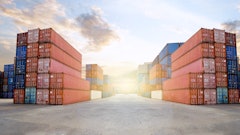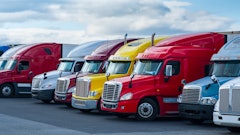
Unsaleable goods are no longer perceived as the supply chain’s unwanted headache. These days the reverse supply chain is gaining the strength and stature of the forward supply chain, thanks to ever-advancing technologies. Today’s dedicated reverse logisticians have the data they need to study and understand how, why, and where along the food supply chain problems ensue that cause damaged and expired food products in the first place. This knowledge helps optimize efficiencies throughout the supply chain to help eliminate unsaleable incidents, resulting in significant sustainability achievements while also uncovering hidden opportunities for new revenue streams.
The sheer numbers of returns in the country are astounding. The National Retail Federation reports that in 2009, 8 percent of sales—or $186 billion worth of merchandise—eventually winds up as returned product for one reason or another. “That is equal to two-thirds of the entire world’s GDP,” reminds Robert Iaria, reverse logistics manager for C.H. Robinson Worldwide Inc. in Eden Prairie, MN. “So folks are realizing that they must pay acute attention to reverse logistics and their unsaleables operations to minimize the associated costs while getting the most value out of these products.”
Inherent in the reverse logistics process are many moving parts, each with its associated cost such as transportation and fuel consumption, inventory planning and management, disposition management, and administrative processes.
Discovering Retrievable Value
A robust reverse logistics program must make intelligent use of data from the reverse logistics flow to facilitate better decision-making on the forward supply chain, notes Gene Bodenheimer, senior vice president of reverse logistics for Pittsburgh-based Genco ATC. “More informed decisions can certainly minimize the amount of product that flows back as a result of poor decision-making on the frontend—or as a result of excess inventory being put into the pipeline.” The more informed the decision-making, the better optimized will be the disposition sequence and the greater the chances are for achieving sustainability goals and for salvaging monetary value that might have been overlooked otherwise.
As companies pay more attention to reverse logistics, they rely on advanced technology that is far better than it ever has been, notes Rich Fanning, executive vice president of operations for Inmar Inc. in Winston-Salem, NC. “They are getting more actionable data that allows them to make the necessary decisions to change something quickly in their process so they can reduce the potential for unsaleables. Our customers can analyze the data they receive based on information they pull from their stores or from us. They can then make smarter decisions about the type and amounts of inventory they will carry.”
Companies need to think more about the inherent value of food and beverage products and how a product nearing the end of its shelf life can maintain some or all of its original value by being transformed into another food product, advises Gailen Vick, president and CEO of Reverse Logistics Association in Lehi, UT. “For instance, a bruised apple might not sell at the retail level. But you can take that apple and make applesauce or you can transform it into a salad. You can take that salad made from a 50-cent apple and donate it at a value of 75 cents. So that unsaleable apple doesn’t have to go through a waste stream that winds up at a hog farm, for example.”
Iaria reports C.H. Robinson does a lot of reverse logistics programs in the food and beverage industry, where technology is appreciated particularly because of the value of the products. “When you think of this industry, it is almost like you can hear the clock ticking on those expiration dates of certain products. So it is extremely critical that you quickly assess where you can get the most value from a product, while minimizing the cost of disposition. What we at Robinson are trying to do is to make that assessment at the instant someone has refused freight or has requested a return, because waiting just minimizes the value of the product. By evaluating these options, you are acting sustainably.”
That assessment includes evaluating if the product has enough value to return into the A-stock inventory if it meets the criteria to return, explains Iaria. If this is not possible, the next step in disposition might be to liquidate the product that still has inherent value into secondary markets such as into closeout or outlet types of operations. Donating the product allows a company to do a tax write-off while avoiding disposal costs involved with the landfilling process.
Of course, the fewer items being returned is the best goal from a sustainability perspective, adds Fanning at Inmar. “But for the items that do return, we optimize that process which begins with as few touches as possible in handling products. “We start by evaluating whether a product can be restocked. If it concerns products at the end of a season or at the end of a promotion, we can help get those products back into inventory to be resold.”
Optimize Your Processes
Among leading reverse logistics providers, sustainability initiatives are inherent components of reverse programs. Experts in reverse logistics agree that optimized efficiencies in the reverse logistics supply chain produce higher levels of sustainability. “The biggest sustainability piece to this puzzle is avoiding altogether the extra costs involved in handling and transporting returned products,” says Iaria at C.H. Robinson. “Our philosophy within our reverse programs is to get as much information from our clients about why freight is being returned or refused. We then dig into that data to uncover root causes so we can help our clients improve their supply chain practices so they don’t have those problems in the future.”
Fanning at Inmar notes that when both the forward and reverse supply chains are optimized, sustainability goals are achieved. “Optimization on the frontend of your supply chain will produce efficiencies on your reverse supply chain that will eliminate waste overall.”
Here are some major areas logisticians focus on for optimization efficiencies resulting in sustainability goals for their customers.
Dig for root causes: Before you can even begin to fix something you know is not working properly, you need to know what it is in your supply chain operation that is resulting in unsaleables. So one of the first steps reverse logisticians take is to analyze the data relative to the root causes of unsaleables in order to help customers minimize incidents of unsaleables overall.
Inmar, for example, spends a significant amount of time and resources examining the entire supply chain of each of its customers, reports Rob Small, senior director of supply chain consulting. “We measure the percentage of unsaleables and then dig down to the root causes so we can begin to prioritize where to look for opportunities to minimize and eliminate these incidences. Many times we find the problem relates to the need to improve packaging design, improve handling practices, optimize inventory level planning and management, or examine product age and expiration dates relative to rotation practices throughout the supply chain.”
Miser-ize your miles: C.H. Robinson’s OS&D (Over, Short, and Damaged Products) program manages and coordinates all refused freight, regardless of the hauling carrier, notes Iaria. “We dedicate an 800-number hotline to each manufacturer, who publishes that number on every bill of lading. Anytime there is a pallet or truckload that is refused, our customers can call the hotline. We gather information relative to the refusals such as the quantity being refused, the value, and the reasons for the refusal and then we apply that information to a formula we co-created with our customers to determine immediate disposition.”
Immediate disposition decisions are critical in preventing costs that continue to accrue as time passes. “Many times refusal requests get passed from one department to another—such as the manufacturer’s transportation department passing along these requests to its customer service group,” explains Iaria. “This critical time lapse means drivers must wait for disposition directions. As a consequence, you have to deal with detention time and idling, each of which reduces your sustainability efforts while increasing your overall costs.”
By examining the best way to return products while minimizing total loaded miles and total out-of-route miles, C.H. Robinson can use its vast network to decrease touch points by dropping off inventory at its closest facility. “So wait times, idle times, and out-of-route miles are reduced,” Iaria explains. “Many times on the returns side, shippers will just say send it back, but this only leads to unnecessary inefficiencies.”
Optimizing the transportation piece of reverse logistics is really about integrating both the forward and reverse supply chains to incorporate all activities involved into your transportation network so the entire network is optimized, notes Small at Inmar. “Transportation planning needs to consider the forward transportation piece as it relates to the events of reverse logistics. An example of this is how important it is to consider backhauls of returned products after a driver has delivered to stores. Moves like these should be entered into the design of your forward and reverse supply chain network.”
Today’s technology helps providers offer cost-saving recommendations that translate to sustainability achievements. For instance, by studying the data relative to a particular client, Inmar recommended how the client could operate a better optimized supply chain. “This was a retailer with a network of many national DCs servicing its stores through each of those DCs that shipped specific products,” reports Small. “We helped them reduce millions of miles of unnecessary transportation annually by recommending that they service their stores regionally out of each DC and cross-dock the different types of products from one DC to another.”
Inmar brings unsaleable products back from stores on a returning truck so no incremental miles are involved, adds Fanning. “Those are miles the trucks are going to run with returnable products anyway. By cross-docking unsaleables, they can fill up a trailer load and deliver those to our facilities—which typically are in close proximity to their DCs. So there are minimal miles driven, which lends this model to sustainability efforts.”
Goldilocks packaging: The packaging question becomes one of finding a solution without over-packaging—which is environmentally unfriendly—and without under-packaging, which can result in unsaleables. There is a big push to reduce packaging materials, reports Bodenheimer at Genco. “Oftentimes there is not enough attention paid to the potential impact on damages and unsaleables on the backend resulting from packaging that is not robust enough to withstand the normal rigors of the supply chain.”
He cautions that too much emphasis on green or sustainable goals can and do lead to serious and costly mistakes if the impact on the entire supply chain is not considered. “You really need to study and understand the data relative to your reverse logistics operation,” continues Bodenheimer. “What might appear to be a very good solution from an environmental and a cost perspective on the frontend by reducing packaging materials can actually affect a detrimental impact on the backend that far outweighs the initial cost savings.”
At the surface level, some could conclude that using a thinner or lesser-weight material for the consumer pack is a good thing because there is less weight and less waste involved, explains Bodenheimer. “The fact is that in the design of primary and secondary packaging, the consumer pack often lends additional support and resistance to compression stresses to the case or to the secondary packaging. So if you reduce the weight of the consumer packaging, that can reduce the ability to support the case.”
For instance, a mayonnaise manufacturer recently had a problem with a packaging solution that was meant to be environmentally sustainable. The mayonnaise was packaged in a glass jar and the jars were packed in full corrugate cases with corrugate dividers to protect the jars from impacting each other. “At some point, the manufacturer made the decision to change the packaging to a tray and shrink-case pack without dividers,” reports Bodenheimer. “There were significant savings and material reduction on the frontend. But the amount of damage due to breakage because of the inability of the new packaging to withstand the rigors of the supply chain was astronomical compared with what the initial savings were. So you really need a monitoring system in place that will help you predict what the impact of any change to packaging might be.”
So how do companies achieve that delicate balance in finding the right packaging solution that is environmentally unfriendly and that eliminates unsaleables? First and foremost, design and test protocols should go beyond just ensuring that the packaging is robust enough to withstand unit-load transport from a manufacturer’s DC to a retail DC, Bodenheimer explains. “It has to survive the entire journey to be considered an effective solution. So the design and test protocol must include the entire supply chain journey. This would also take into account reasonable and normal handling practices throughout the retail distribution network.”
The robust database of information relative to the reverse flow can help companies make the right decisions as they contemplate changes in packaging. “Look at what you know from what has happened in the past so you can do the root-cause analysis to understand why things have gone wrong so you can avoid potential mistakes,” advises Bodenheimer.
Examination of the data can help you determine if there is a particular type of packaging material that has a higher incidence rate of returns due to damages, continues Bodenheimer. “Then you can do a deeper investigation into what is driving those damages and where they are happening along your supply chain. You can then drive continuous improvement initiatives to change the packaging or change the way it is handled or palletized.”
He points to a customer’s problem with one product line, where it was determined that the coverage on the pallets was insufficient, resulting in compression damage to cases. “We increased the deck coverage and that eliminated the compression damage. So this is an example of how data relating to damage or packaging type can help drive a decision to improve performance on the frontend.”
Inventory story: Inventory management is another area that can result in minimizing unsaleables while increasing sustainability efforts. Inmar helps clients understand the cause of problems in their supply chain relative to turns or inappropriate handling or shelf levels, notes Fanning. “We can help them identify items that may not be moving or that have code-dating issues. Doing this helps them minimize unsaleables such as products that have to be removed from the shelf because they didn’t sell in time or because they didn’t have the right amount of turns.”
Inmar conducted collaborative studies with manufacturers and retailers in several channels to examine what contributes to expired rates and discovered that rotation practices and inventory management are critical factors. “We have actually had a reduction across our client base in the food and beverage industry over the past three years of nearly 40 percent on damages and 30 percent on expired products because of many factors including the increased focus on optimal inventory management, packaging, and collaborative data analysis,” reports Small.
Mission: Disposition
For unsaleable products that are unsuitable to reenter the primary channel for sale to consumers, secondary markets offer a good alternative, notes Bodenheimer. “This option offers the ultimate prevention of waste because the products are still being used as the manufacturer originally intended them to be used. This option also offers a substantial revenue stream. After all, the intent for any manufacturer in the CPG world is to get products into the hands of consumers for consumption.”
If remarketing is not a viable option, the product can be broken down into its various components such as packaging materials, the plastic or glass container storing the food product, and the food product itself. “Having a provider whose business it is to know what is recyclable and how to recycle in a cost-effective and compliant manner is essential to any returns program with sustainability goals,” notes Bodenheimer.
Reverse logistics providers have networks of various waste streams effecting the disposition process. For example, C.H. Robinson recently helped a manufacturer of mayonnaise dispose of the food product. “Instead of bringing it to a traditional landfill because it was out of spec, we sent the mayo to be used in an animal feed waste stream and we recycled the glass,” reports Iaria. “We try everything possible in our program to avoid landfill options at any cost. Our customers are also pushing us more these days to find better solutions that impact sustainability.”
Fanning at Inmar notes that the company is moving more into single-stream waste environments. “This allows us to put glass, plastic, and paper together so when those materials arrive at a recycling plant, the different materials get separated out. Having a single stream helps reduce the number of touches involved, helping contain costs and requiring less transportation which affects our sustainability goals.”
Keeping the amount of material that is sent to landfills at a minimum has sustainability benefits, as well as cost benefits. “The green initiative is a big and important part, but from a more practical standpoint, the paperwork and permitting required to dispose in a landfill is very cumbersome and the costs are quite high,” reports Iaria. “So when you are directing these products into channels where people actually want these products, and recyclers can make money, your costs are a lot less than they would be having a fixed-cost type of situation when you send materials to a landfill.”
Clearly, there is an acute awakening in the industry as to the criticality of expedient disposition of unsaleables. Vick at RLA reports increased interest in executives wanting to become certified in reverse logistics through the association’s educational programs. More information is available at www.rla.org.
“The thing to remember is that returns are probably always going to happen,” reminds Iaria. “But you can get better at minimizing the occurrence of unsaleables by making the right decision and by doing the right thing every single time.”
# # #








